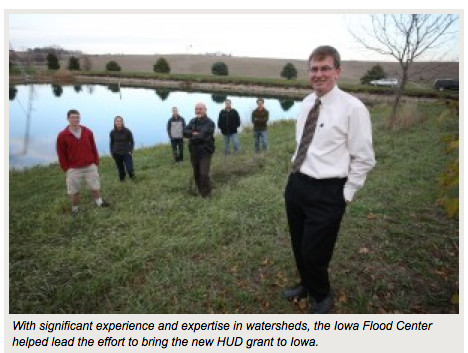Excerpts Provided by
Cedar Rapids Gazette
Iowa received a $97 million boost Thursday in its efforts to make the state more resilient to flooding and to reduce nutrient pollution, with a major role played by the Iowa Flood

Center, a unit of IIHR--Hydroscience & Engineering.
Iowa’s leadership in establishing the Iowa Flood Center and in initiating its Nutrient Reduction Strategy were “big factors” in its prevailing in the competition with 39 other finalists.
“This is a big deal,” said Ben Hammes, spokesman for Gov. Terry Branstad, who along with other state and federal officials will disclose details of the U.S. Department of Housing and Urban Development grant at a news conference Friday in Des Moines.
The expertise and leadership developed through the flood center, established by the Legislature after the devastating 2008 floods, and the Iowa Nutrient Reduction Program, initiated in 2013, “allowed us to be successful in the grant competition,” said Larry Weber, director of IIHR which helped draft the application.
Iowa will receive $96,887,177 in National Disaster Resilience Competition funding to support the Iowa Watershed Approach, a holistic watershed-scale program designed to sustain the state’s farm economy while protecting vulnerable communities from flooding and water pollution.
“ ... Iowa’s modern agriculture landscape has altered the movement of water within the state’s watersheds and reduced the land’s natural resiliency, which impacts peak water flows, flooding, and water quality, especially during extreme weather events,” reads an application for the grant.
HUD funding will enable several watersheds to form Watershed Management Authorities, which will develop assessments and plans and implement pilot conservation projects. The grant also will target funding to Dubuque to make homes less vulnerable to periodic flooding along Bee Creek.
The HUD grant, combined with recent increased conservation allocations from the U.S. Department of Agriculture and proposals to increase state conservation funding, may signal a turning point in efforts to adequately fund Iowa projects for limiting flood damage and nutrient pollution, Hammes said.
Iowa does seem to have help coming from multiple directions, Weber said.
With funding going to both cities and agricultural areas, “we hope it will decrease tension and encourage cooperation” between rural and urban sectors that have been divided by the Des Moines Water Works’ lawsuit against northwest Iowa tile drainage districts, Hammes said.
Iowa is among eight states and five cities awarded a combined $1 billion through the federal program.
Iowa’s grant was the fourth highest, topped by $176 million to New York City, $140 million to New Orleans and $121 million to Virginia.
Grant details were be announced at the Capitol at 1 p.m. Friday by Branstad, Lt. Gov. Kim Reynolds and Iowa Agriculture Secretary Bill Northey, who will discuss efforts to help accelerate flood reduction and water quality efforts in key watersheds around the state.
Several Eastern Iowa counties — including Iowa, Johnson, Winneshiek, Allamakee, Buchanan, Delaware and Tama — were targeted for resources in the state’s grant application.
Those counties experienced excessive losses of topsoil due to disasters, the application said, which led to more sediment and nutrient pollution seeping into waterways.
“Because topsoil takes generations to regenerate, the loss of this resource can be considered permanent as the needs of continued production outstrip nature’s ability to replenish the soil,” the application said.
Citing long-term data showing increased heavy precipitation and flooding, the state’s application advocates the Iowa Watershed Approach, designed to reduce flood risk, improve water quality, increase resilience, engage stakeholders and improve quality of life and health through a scalable and replicable program.